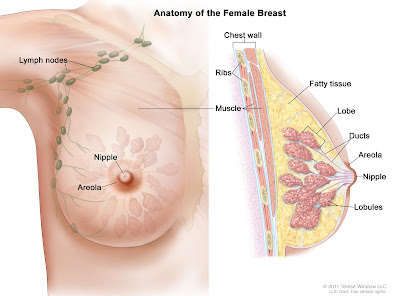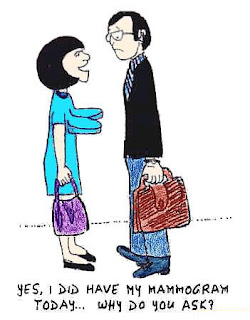Breast Cancer Basics
Senos, ta-tas, the twins/girls, airbags, funbags, headlights, and in New Jersey some people like to call them “bubbies”. Whatever you may like to call them, with the latest statistics reporting that 1 in 8 women will be affected by breast cancer in their lifetimes, we should all know what the basics of this disease are so we can better protect them!
Breast cancer is the second most common cancer in women living in the US, and is a malignant tumor starting in the cells that make up the breast, usually the lobules (where milk is made) and ducts (tubes that bring the milk to the nipples).
Risk Factors
Risk factors let us know what our chances are of possibly developing a disease. Having one or all of the following risk factors does not mean you are going to develop breast cancer, just like not having any does not mean you cannot develop breast cancer.
- Gender – While men can also develop breast cancer, it is 100 times more common in women
- Age – You can get breast cancer at any age, but your risk increases as you get older
- Genetics – Mutation of two genes BRCA1 & BRCA2 can increase your lifetime risk for breast cancer up to 80%.
- Race – The American Cancer Society states that white women are slightly more likely to develop breast cancer that African-American women, but African American women are more likely to die from it. In women under 45 years of age, breast cancer is more common in African American women.
- Lifestyle – There are some studies to suggest an increase in risk with regards to obesity and alcohol consumption.
Signs & Symptoms
Changes in the look or feel of the breast and/or nipple may be warning signs that something is not right and should be investigated further by your doctor including:
- Nipple discharge that starts suddenly
- New pain in the breast area that does not go away
- Lump or thickening inside the breast or underarm area
- Redness, swelling or darkening of the breast
- Rash, scaly sore on the nipple
- Dimpling or puckering
Early detection saves lives! The American Cancer Society recommends women 40 and older have a mammogram every year. Clinical breast exams performed by your trained health care provider as part of your routine medical checkup starting at the age of 20 is also recommended. There is chatter over how effective a self breast exam can be used as a screening tool. You should talk with your doctor more about the pros and cons of doing a self breast exam, but more importantly, you should know what your breast feel like, what’s “normal” and always report any changes to your breasts.
Take responsibility for your health and keep asking questions and get a second opinion if your concerns go unanswered. I remember my friend, breast cancer survivor and advocate Marlena Ortiz, tell me how because she was so young and without a history of breast cancer in her family, the first doctor she went to did not take her concerns about a lump she felt seriously. She followed her instincts and sought another opinion and was subsequently diagnosed with breast cancer. I will never forget Marlena telling me; ” if I would have never gotten a second opinion, I doubt I would be able to advise others about how important it is to self-examine. Do not let fear stop you from taking care of yourself. If you don’t have your health, what do you have? Love yourself enough to better your health”.
Sources of information, please visit:
WomensHealth.gov
American Cancer Society
Susan G. Komen

